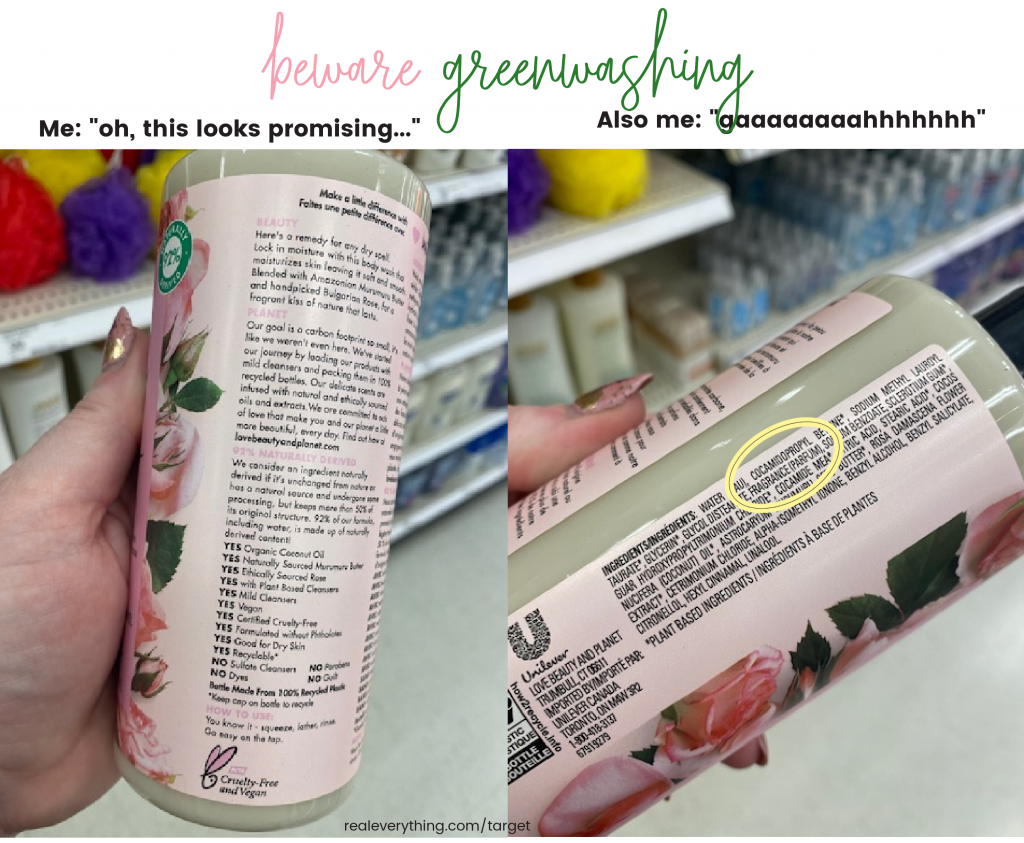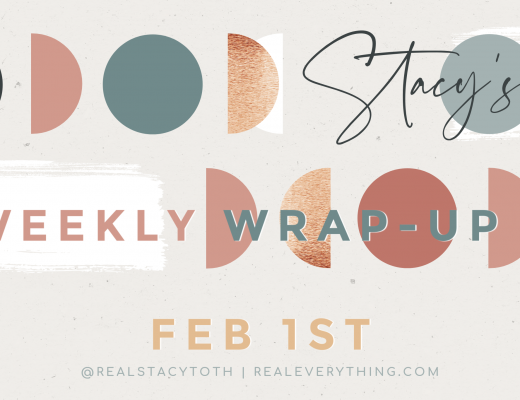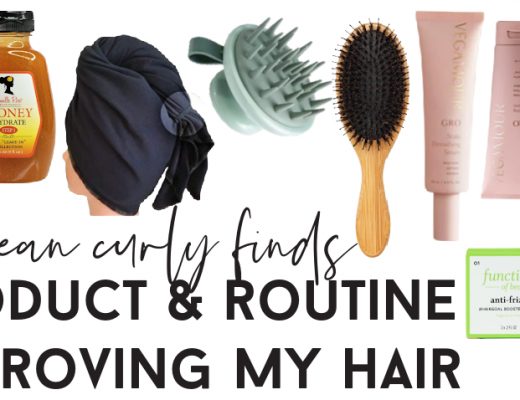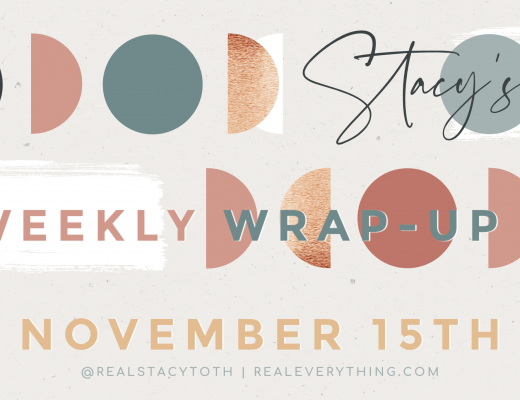The irony of cleaning products adding toxins to your home is confounding. Greenwashing, especially for cleaning products, is rampant. Problem is, it’s impossible to know what all those ingredients are or who to trust. I know I’m not the only one trying to figure out if items meet my non-toxic requirements. Since Target has both dedicated sections for clean and zero waste – making it an ideal place to identify and research brands marketing their products as green. I spent weeks culling through all the items, looking them up, and creating this resource for myself. I figure I could save you all time by sharing what I’ve found! Digging in even more online I’ve compiled the ultimate list – Natural or Not: Target Clean Cleaning Household Goods Guide.
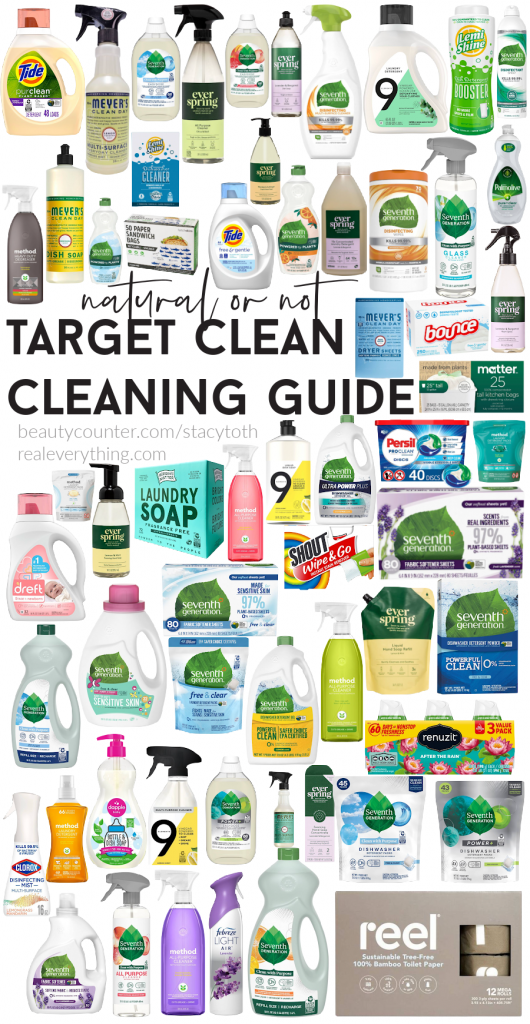 pin this image to share or save and come back to
pin this image to share or save and come back to
You can find my Target Clean Product Guide & Clean Personal Product Shopping List here
note: I have not tested or used some of these products, except where noted, I am simply sharing what I would or wouldn’t buy or use – based on ingredients and reviews
EWG’s Cleaning Guide uses an A-F scale (vs. Skin Deep Database using a 1-10 scale). Ratings are as follows:
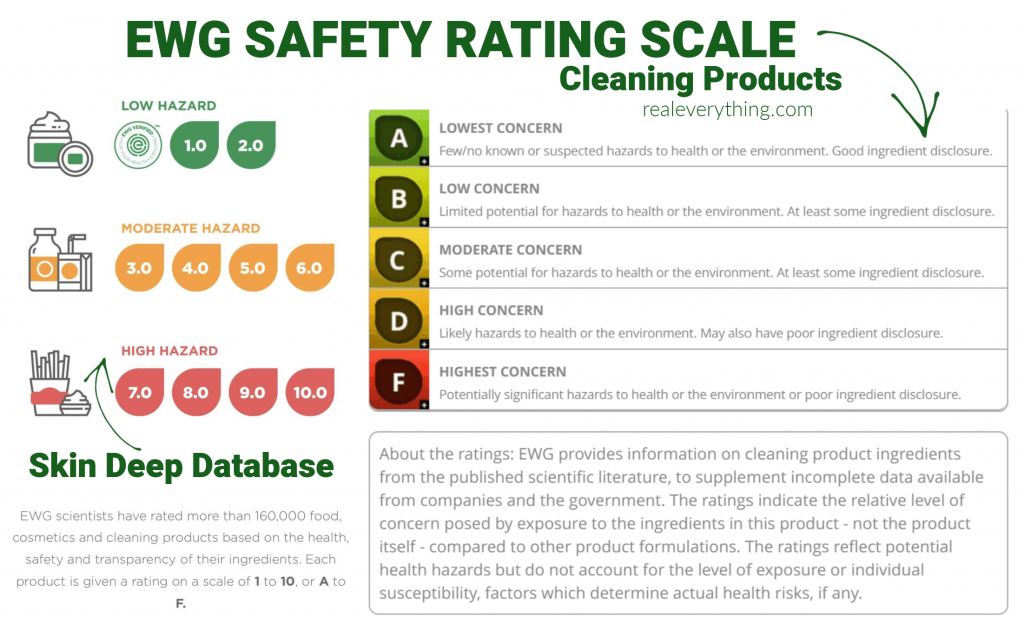
For perspective of HOW BAD cleaning product ingredients are, EWG has 53 verified cleaning products (here) while their Skin Deep database has Verified 2,088 (here).
My Brands of Choice:
While I’m going to dive deep into what is note as “clean” on Target’s website, the brands my family has come to use and love are:
Dropps – laundry and dishes
Biome – disinfecting wipes
Who Gives a Crap – bamboo paper products
Force of Nature – all purpose cleaner
This is the easiest way for me to stop worrying about deciphering ingredient labels. It uses electricity to convert salt, water & vinegar into a cleaner and EPA registered disinfectant as effective as bleach – without harmful chemicals. No dyes, fragrances, preservatives, allergens or irritants, no mysterious ingredient list. And it powers through grease, grime, soap scum & odors as effectively as top conventional brands but without the nasty chemicals you don’t want around your children & pets. It’s even gentle on skin, with no toxic residues to harm the little hands in your home, no rinsing needed. It kills 99.9% of viruses and bacteria and meets EPA standards as a Hospital-Grade Disinfectant. Force of Nature is also on EPA’s list N, the disinfectants approved for use against SARS-CoV-2, the cause of COVID-19, and EPA expects all products on List N to kill all strains and variants of SARS-CoV-2.
The Real Deal – greenwashing, safety, testing and more:
What cleaning products are safe?
Sadly, many cleaners labeled as “natural” contain dangerous fragrances, dyes, preservatives, allergens & irritants. Check out these surprising safety ratings from the Environmental Working Group (EWG) that show “natural” brands earning the same safety ratings of “high” or “highest” concern – comparable to standard, conventional cleaners:

So as much as you might want your children to help you clean, you can’t be sure your “natural” cleaning product is actually safe enough to use around them.
Are “Natural” cleaners are toxic-free?
Unfortunately, No. Federal regulations don’t define proper standards for products labeled as “natural”. So while you may think “natural” means no dangerous chemicals, that’s actually not at all the case. While many natural cleaners may be somewhat safer than conventional cleaners (why is the less safe one even on the market?!), the reality is that many products labeled as “natural” are actually not at all. Maybe a small percentage of the product contains an ingredient that isn’t synthetic. That does not qualify as safe or non-toxic.
How can I tell what ingredients are in my cleaning products?
I wish we could! Like personal care products loopholes with an outdated law (1938), cleaning products aren’t far behind (1976). So many more chemicals exist now than when the law was established! Manufacturers of cleaning products are not required to disclose all of their products’ ingredients on their packaging labels. Shocking, right? How do you find toxic chemical free cleaners? First, look for specificity. Many manufacturers use vague terms that can hide all sorts of toxic ingredients. For example “fragrance” can actually mean a cocktail of undisclosed ingredients, when even natural fragrances can cause allergic reactions. Other vague descriptions to watch for are “surfactants“, “cleaning agents” or “preservatives”, where the lack of specificity means you can’t easily research the ingredients yourself. An example is methylisothiazolinone, which is often just labelled as “preservative”. Given its association with lung toxicity, allergies, and possible neurotoxicity – brands often “hide” it.
Does the government test and regulate safety of cleaning products?
Ready for a jaw-dropper? Out of some 62,000 chemicals approved for use in the US, only about 300 have actually been tested for safety. The last time the law governing the safety of chemical products was changed, the cost of gas was $.59 a gallon and the average cost of a new house was $43,400: 1976. That means the onus is really on you to do your own research.
The good news: the Environmental Working Group, which has a searchable database of products, is an excellent resource for researching cleaning product health and environmental safety.
[source: read more at Force of Nature’s website]
Why does the Target Lists (safe and less safe) repeat the same brands?
You’ll notice that many brands are on both the “Natural and Not” list. I’ve specifically noted products that are the same brand in both categories. This is part of what requires the extra effort to be your own expert and advocate – formulas vary in brands, so we must be diligent in always checking labels – even with re-purchase, because formulas can change without you realizing it.
This is why I personally use Beautycounter as often as possible, but obviously they don’t make cleaning products. Target has been my go-to lately, with tons of green options. Their “Zero Waste” and “Clean” categorization makes finding options easy… But, there’s also a LOT of greenwashing.
What is Greenwashing?
Brands know that the majority of consumers are looking for cleaner products. But most aren’t willing to fully bare the expense of change formulas and packaging to truly commit to clean. So they will “sell” you on words that aren’t legally regulated or defined, like “natural” and “clean”. It’s all subjective, and if they say it is – it is.
But why is labeling subjective? Since the Federal Regulation hasn’t been updated since 1976, the ingredients brands use and the way they market and label is a complete free-for-all. The FDA doesn’t have the ability to issue a recall, even when known carcinogens like benzene is in widely used hand sanitizer. Yes, seriously. I say this because:
a) clean products are so needed and I’m thrilled to see so many more options and brands getting on board, but
b) brands are aware there is a consumer desire for clean products, and they’ll brand accordingly – even if it’s not true.
The words you see on the front of the label do.not.matter. We as consumers MUST read the ingredient label. And sometimes, even check their website for full ingredient disclosure, or check EWG if we don’t have the time, ability or understanding of those labels.
I’ve done that for you here, to the best of my abilities with the info I could find. Keep in mind, all of these are my own personal preferences, based on a few criteria:
- Non-toxic (clean, safe) ingredients
- Testing standards
- Fragrance (absolute no-go)
- Brand commitment
While I mention it below as well – keep in mind that items breathed or consumed are absorbed at a higher rate by your body. We have lots of data to support that inhaled cleaning products cause harm to our health – so if you do need to be around less safe options, wear a mask! [source & more info].
What to Look for and Why
EWG’s key scientific findings:
- Some 53 percent of cleaning products assessed by EWG contain ingredients known to harm the lungs. About 22 percent contain chemicals reported to cause asthma to develop in otherwise healthy individuals.
- Formaldehyde, a known human carcinogen, is sometimes used as a preservative or may be released by other preservatives in cleaning products. It may form when terpenes, found in citrus and pine oil cleaners and in some essential oils used as scents, react with ozone in the air.
- The chemical 1,4-dioxane, a suspected human carcinogen, is a common contaminant of widely-used detergent chemicals.
- Chloroform, a suspected human carcinogen, sometimes escapes in fumes released by products containing chlorine bleach.
- Quaternary ammonium compounds (“quats”) like benzalkonium chloride, found in antibacterial spray cleaners and fabric softeners, can cause asthma.
- Sodium borate, also known as borax, and boric acid are added to many products as cleaning agents, enzyme stabilizers or for other functions. They can disrupt the hormone system.
- Many leading “green” brands sell superior products, among them Green Shield Organic and Whole Foods’ Green Mission brand. But not all cleaners marketed as environmentally conscious score high. Some “green” brands such as Earth Friendly Products do not disclose ingredients adequately.
EWG recommends avoiding some products altogether because they’re unnecessary or there are no safer alternatives. Among them:
- Air fresheners contain secret fragrance mixtures that can trigger allergies and asthma. Open windows or use fans.
- Antibacterial products can spur development of drug-resistant superbugs.
- Fabric softener and dryer sheet ingredients can cause allergies or asthma and can irritate the lungs. Try a little vinegar in the rinse cycle.
- Caustic drain cleaners and oven cleaners can burn eyes and skin. Use a drain snake or plunger in drains. Try a do-it-yourself paste of baking soda and water in the oven. [source]
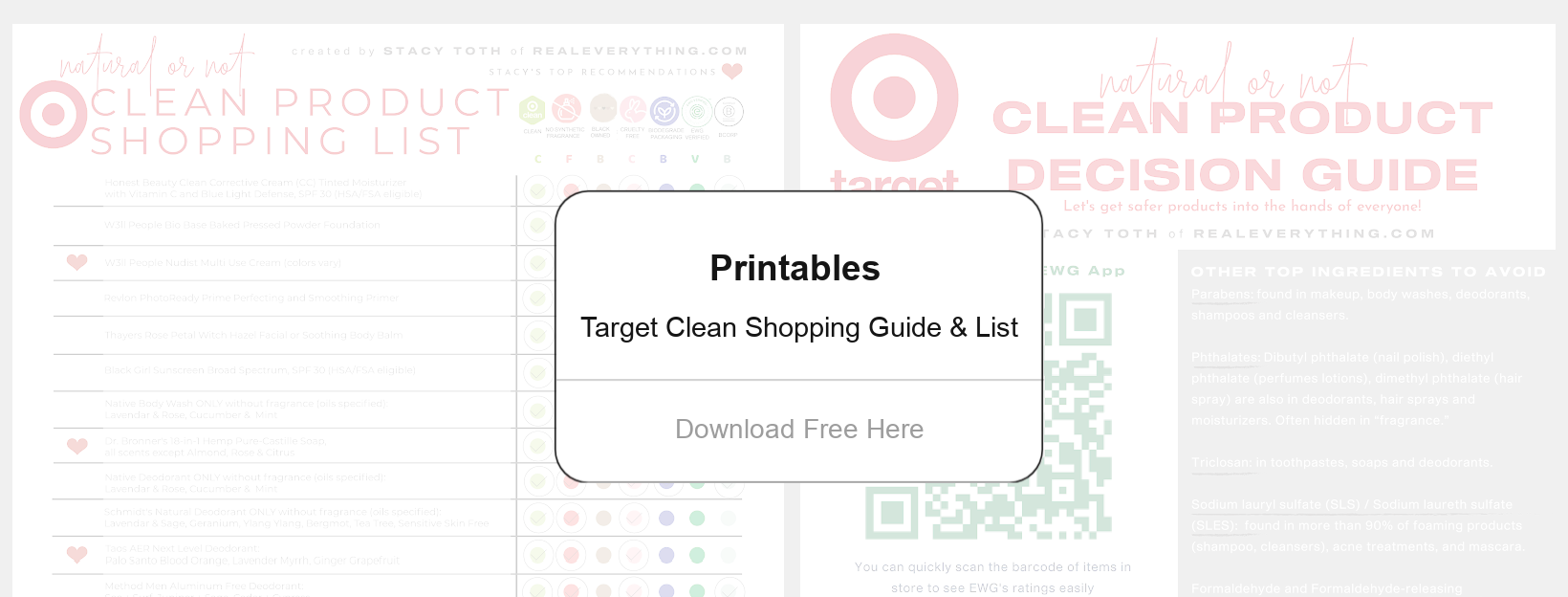 free download: my decision guide helps you navigate quickly & easily
free download: my decision guide helps you navigate quickly & easily
Note, the Clan Product Shopping List also includes specifics of which brands and items are:
- zero waste
- non-toxic
- cruelty free
- biodegradable
- plant-based
- b corp
- black owned
Natural: what are the natural, clean, green, non-toxic products?
Keep in mind that ALL of these are marketed as “clean” via Target’s website.
Dish Soap & Detergent
Seventh Generation
- Seventh Generation Natural Dishwasher Detergent Packs Free & Clear EWG A
- Seventh Generation Ultra Power Plus Dishwasher Detergent Packs EWG A
- Seventh Generation Dishwasher Detergent Powder Free & Clear EWG A
- Seventh Generation Zero Plastic Auto Dishwasher Powder – Fragrance Free EWG A
Method
- Method Dishwasher Packs Free + Clear EWG B
- Method Auto Dish Heavy Duty Dishwasher Packs EWG B
Other
- 9 Elements Liquid Dish – Lemon EWG A
- 9 Elements Liquid Dish – Eucalyptus EWG A
- Dapple Bottle & Dish Soap – Fragrance Free EWG B
- Dapple Baby Bottle & Dish Soap – Sweet Lavender EWG B
- Lemi Shine Rinse Dish Cleaner EWG B
Laundry
Seventh Generation
- Seventh Generation Fabric Softener Sheets Free & Clear EWG B
- Seventh Generation Fabric Softener Sheets Fresh Lavender Scent EWG B
- Seventh Generation Laundry Packs Free & Clear EWG B
- Seventh Generation Natural Fabric Softener Sheets – Free & Clear EWG B
- Seventh Generation Zero Plastic Powder Laundry Detergent Soap – Citrus & Sandalwood EWG A
Everspring
- Liquid Laundry Detergent – Free & Clear EWG B
- 100% New Zealand Wool Dryer Balls
Method
- Method Laundry Detergent Packs Free + Clear EWG B
9 Elements
- 9 Elements Liquid Laundry Detergent – Eucalyptus EWG A
- 9 Elements Liquid Laundry Detergent – Lemon EWG A
- 9 Elements Lemon Scent Liquid Purifying Softener EWG A
- 9 Elements Eucalyptus Scent Liquid Purifying Softener EWG A
Mrs. Meyer’s
- Mrs. Meyer’s Clean Day Dryer Sheets – Lavender EWG B
Others
- Biokleen Bac Out Stain & Odor Eliminator EWG B
- Ingredients Matter Fragrance Free Laundry Soap Powder EWG A
- Ingredients Matter Lavender Laundry Soap Powder EWG B
Mainstream Brands
- OxiClean Powder Versatile Stain Remover Free EWG B
Room Spray & Air Fresheners
- Everspring Room Spray Lavender & Bergamot EWG B
- Mrs. Meyer’s Lavender Room Freshener Spray EWG B
- Mrs. Meyer’s Basil Room Freshener EWG B
- Mrs. Meyer’s Geranium Room Freshener EWG B
Disinfecting Wipes & Sprays
Seventh Generation
- Seventh Generation Lemongrass Citrus Disinfecting Wipes EWG A
- Seventh Generation Disinfectant Spray Eucalyptus & Spearmint EWG A
Everspring
- Multi-Surface Cleaning Wipes Lemon & Mint EWG B
- Multi-Surface Cleaning Wipes Citrus & Basil EWG B
All Purpose or Multi-Surface Cleaners
Everspring
- All Purpose Cleaner, Citrus & Basil – EWG B
- All Purpose Cleaner, Lavender & Bergamot – EWG B
- All Purpose Cleaner, Lemon & Mint – EWG B
- All Purpose Cleaner, Mandarin & Ginger – EWG B
Seventh Generation
- Seventh Generation Lemongrass Citrus Disinfecting Multi-Surface Cleaner EWG B
Puracy
- Natural Everyday Surface Cleaner Just Add Water – Green Tea & Lime EWG A
- Natural Everyday Surface Cleaner Concentrate Refills – Green Tea & Lime EWG A
Method
- Method All Purpose Surface – Spray Pink Grapefruit EWG B
Other
- 9 Elements Multi-Purpose Cleaner – Lemon EWG A
- Clorox Commercial Solutions Disinfecting Bio Stain & Odor Remover EWG A
Specific Cleaners
- Clorox Pet Solutions Advanced Disinfecting Stain & Odor Remover EWG A
- Everspring Glass Cleaner – Lemon & Mint EWG B
Toilet Paper
- Reel Premium Bamboo Toilet Paper
Target Zero and Black-Owned; fragrance/bpa/chlorine-free; 100% bamboo & tree-free
Packaging
- Lunchskins Recyclable & Sealable Paper Sandwich and XL Quart Size Bags
Target Zero, Women Owned Brand, Made from all-natural glassine (pure wood pulp) FSC-Certified Paper, durable with pleated sides and self-adhesive closure strip to seal. - Matter 100% Compostable Sandwich Bags
Target Zero, 100% Compostable, BPA-free - Matter 100% Compostable Fiber Plates 10″ and Bowls
Target Zero, 100% Compostable - Grove Co. Reusable Cleaning Glass Spray Bottle with Silicone Sleeve
Target Zero, Sustainably crafted for the long run, re-usable glass - Grove Co. Hand Soap Glass Dispenser
Target Zero, partially-recycled glass, lead-free and stainless steel pump - Matter 100% Compostable Tall Kitchen Trash Bags
Target Zero, 100% compostable, made from sustainable and renewable materials
Not: what are the products I’d avoid and why?
I want to emphasize that just because you see a certain brand above, does not mean all products by them are “clean.” Plus, the following are by my own definition “not natural” – many because of fragrance, which we know can hide hundreds of hazardous chemicals. It makes it harder to not just be able to trust and grab a certain brand you like. And here’s a list of what I avoid…
Dish Soap & Detergent
Seventh Generation
- Seventh Generation Dish Liquid Soap – Lemongrass & Clementine EWG C
- Seventh Generation Dish Liquid Soap – Lavender & Mint EWG C
- Seventh Generation Dish Liquid Soap – Free & Clear EWG C
- Seventh Generation Dish Liquid, Summer Orchard – EWG D
- Seventh Generation Natural Dish Liquid, Fresh Citrus & Ginger – EWG D
- Seventh Generation Natural Dish Liquid Soap – Free & Clear – EWG C
- Seventh Generation Natural Dish Liquid, Clementine Zest & Lemongrass – EWG C
- Seventh Generation Natural Dish Liquid, Lavender Flower & Mint – EWG C
- Seventh Generation Natural Dishwasher Lemon Detergent Gel EWG D
- Seventh Generation Ultra Power Plus Dish Liquid, Fresh Citrus Scent – EWG C
Palmolive
- Palmolive Ultra Pure + Clear Liquid Dish Soap – Spring Fresh EWG F
- Palmolive Ultra Pure + Clear Liquid Dish Soap – Lavender and Eucalyptus EWG F
- Palmolive Ultra Pure + Clear Liquid Dish Soap – Detergent Fragrance-free EWG F
- Palmolive Ultra Liquid Dish Soap Detergent – Oxy Power Degreaser
- Palmolive Ultra Liquid Dish Soap Detergent – Original EWG D
Everspring
- Liquid Dish Soap – Lemon & Mint EWG D
- Liquid Dish Soap – Lavender & Bergamot EWG D
- Liquid Dish Soap – Mandarin & Ginger EWG D
- Liquid Dish Soap – Free & Clear EWG D
Mrs. Meyer’s
- Mrs. Meyer’s Clean Day Liquid Dish Soap Lemon Verbena EWG D
- Mrs. Meyer’s Clean Day Liquid Dish Soap Honeysuckle Scent EWG D
- Mrs. Meyer’s Clean Day Liquid Dish Soap Basil Scent EWG D
- Mrs. Meyer’s Clean Day Liquid Dish Soap Lavender Scent EWG D
- Mrs. Meyer’s Clean Day Liquid Dish Soap Geranium Scent EWG D
- Mrs. Meyer’s Clean Day Liquid Dish Soap Peony Scent EWG D
- Mrs. Meyer’s Clean Day Dish Soap – Rose EWG D
- Mrs. Meyer’s Clean Day Dish Soap – Mint EWG D
- Mrs. Meyer’s Clean Day Dish Soap – Daisy EWG D
Method
- Method Dish Soap Lime & Sea Salt EWG D
- Method Ginger Mango Dryer Sheets EWG D
- Method Beach Sage Dryer Sheets EWG D
Other
- Dapple Baby Bottle & Dish Soap – Mango Melon Scent EWG C
- Lemi Shine Dish Detergent Booster EWG C
- Lemi Shine Dishwasher Cleaner EWG C
- Cascade Free & Clear Gel Lemon Essence Disinfectant EWG D
- Cascade Free & Clear Action Pacs Lemon Essence Dishwasher Detergent Pods EWG D
Laundry
Seventh Generation
- Seventh Generation Natural Laundry Detergent Free & Clear Sensitive Skin EWG D
- Seventh Generation Natural Laundry Detergent Fresh Citrus EWG D
- Seventh Generation Natural Liquid Laundry Detergent Alpine Falls EWG D
- Seventh Generation Power Plus Laundry Detergent – Clean Scent EWG D
- Seventh Generation Power + Liquid Laundry Detergent Soap Unscented EWG D
- Seventh Generation Free & Clear Ultra-Concentrated Laundry Detergent EWG D
- Seventh Generation EasyDose Liquid Laundry Detergent – Rose EWG D
- Seventh Generation EasyDose Ultra Concentrated Liquid Laundry Detergent Soap – Mango & Mandarin EWG D
- Seventh Generation Easy Dose Ultra Concentrated Laundry Detergent Lavender EWG D
- Seventh Generation Liquid Laundry Detergent Soap – Fresh Lavender Scent EWG D
- Seventh Generation Liquid Laundry Detergent – Sage and Cedar EWG D
- Seventh Generation Liquid Laundry Detergent Soap – Hypoallergenic Free & Clear Unscented EWG D
- Seventh Generation EasyDose Ultra Concentrated Liquid Laundry Detergent Soap – Mango & Mandarin Scent EWG D
- Seventh Generation Laundry Stain Removers Free & Clear EWG D
- Seventh Generation Fabric Softener Lavender EWG D
Method
- method Laundry Detergent Free + Clear EWG C
- method Laundry Detergent Ginger Mango EWG C
- method Laundry Detergent Beach Sage EWG C
- method Laundry Detergent Fresh Air EWG C
- Method Coconut + Cactus Water Laundry Detergent EWG D
- Method Ginger Mango Laundry Detergent Packs EWG D
- Method Beach Sage Laundry Detergent Packs EWG C
- Method Fresh Air Fabric Softener EWG D
- Method Beach Sage Liquid Fabric Softener EWG D
Mrs. Meyer’s
- Mrs. Meyer’s Clean Day Scent Free Laundry Detergent EWG F
- Mrs. Meyer’s Clean Day Lavender Laundry Detergent EWG D
- Mrs. Meyer’s Clean Day Honeysuckle Laundry Detergent EWG D
- Mrs. Meyer’s Clean Day Fabric Softener – Rain Water EWG D
- Mrs. Meyer’s Clean Day Fabric Softener – Lavender EWG D
Others
- Babyganics 3x Laundry Detergent Fragrance Free EWG F
- Puracy Natural Baby Laundry Stain Remover with Plant Powered Enzymes Free & Clear EWG D
Mainstream Brands
- Shout Wipe & Go Instant Stain Remover EWG D
- Tide High Efficiency Liquid Laundry Detergent – Free & Gentle EWG D
- Tide Ultra Stain Release FREE Liquid Laundry Detergent EWG F
- Tide purclean Unscented Liquid Laundry Detergent EWG F
- Tide purclean Honey Lavender Liquid Laundry Detergent EWG F
- Bounce Free & Gentle Unscented Fabric Softener Dryer Sheets for Sensitive Skin EWG C
- Arm Hammer Sensitive Liquid Laundry Detergent – Free & Clear. EWG D
- Purex with Oxi Liquid Laundry Detergent EWG D
- Downy Ultra Free & Gentle Liquid Fabric Conditioner – Unscented EWG C
- Dreft Stage 1: Newborn Liquid Laundry Detergent EWG F
- Dreft Family Friendly Unscented Liquid Baby laundry Detergent EWG D
- Dreft Pure Gentleness Fragrance Free Liquid Baby Laundry Detergent EWG F
- Persil Discs Laundry Detergent Pacs Original EWG F
- Gain Botanicals Plant Based White Tea & Lavender HE Compatible Liquid Laundry Detergent EWG F
Room Spray & Air Fresheners
- Everspring Room Spray Lemon & Mint EWG D
- Everspring Room Spray Mandarin & Ginger EWG D
- Renuzit Gel Air Freshener – After the Rain EWG D
- Renuzit Tough on Pet Odors Gel Air Freshener – Pure Breeze EWG D
- Air Wick Scented Oil – Lavender & Chamomile EWG D
- Air Wick Scented Oil – Fresh Waters EWG D
“smells amazingly natural” - Febreze Light Odor Eliminating Air Freshener Room Spray – Sea Spray Scent EWG F
“no heavy perfumes”
Disinfecting Wipes & Sprays
Method
- Method All Purpose Wipes Lime and Sea Salt EWG F
- Method All Purpose Wipes Pink Grapefruit EWG D
Clorox Compostable Wipes
- Simply Lemon – Target Zero, Plant Based, Multi-Surface, contains Fragrance EWG D
- Free & Clear – Target Zero, No Synthetic Fragrance, Plant Based, Multi-Surface EWG D
All Purpose or Multi-Surface Cleaners
Method
- Method All Purpose Cleaners – French Lavender Spray Bottle EWG F
- Method Cleaning Products APC Lime + Sea Salt Spray Bottle EWG F
Seventh Generation
- Seventh Generation All Purpose Cleaner Free & Clear EWG C
Clorox
- Clorox Disinfecting Mist – Lemongrass Mandarin EWG D
- Clorox Disinfecting Mist – Eucalyptus Peppermint EWG D
Mrs. Meyer’s
- Mrs. Meyer’s Peony Scented Multi-Surface Everyday Cleaner EWG D
- Mrs. Meyer’s Lemon Verbena Multi-Surface Everyday Cleaner EWG D
- Mrs. Meyer’s Lavender Multi-Surface Everyday Cleaner EWG D
- Mrs. Meyer’s Clean Day Liquid All Purpose Cleaner – Lilac EWG D
- Mrs. Meyer’s Clean Day Liquid All Purpose Cleaner – Rose EWG D
- Mrs. Meyer’s Clean Day Liquid All Purpose Cleaner – Mint EWG D
- Mrs. Meyer’s Clean Day Multi-Surface Cleaner – Daisy EWG D
- Mrs. Meyer’s Clean Day Honeysuckle Scent Multi-Surface Everyday Cleaner EWG D
- Mrs. Meyer’s Clean Day Basil Scent Multi-Surface Everyday Cleaner EWG D
- Mrs. Meyer’s Lavender Multi-Surface Concentrate EWG D
Specific Cleaners
- Seventh Generation Sparkling Sea Glass Cleaner EWG C
- Scrubbing Bubbles Dissolve Pods Bathroom Cleaner Starter Kit EWG D
- Method Cleaning Products Kitchen Degreaser Lemongrass EWG D
Top Ingredients to Avoid
While this was originally written for my clean personal products article, these ingredients are also found in cleaning products – and will remain in the air (lungs absorb at a higher rate) or on your skin.
Why is Fragrance so bad?
You’ll notice that “fragrance” or “parfume” or “scent” is the reason that both myself and EWG rate certain items as a higher risk. Remember, even if a brand says “natural” there is no defined standard for what that means. There’s no safety testing of an item, either. So, even if a brand has the best of intentions and thinks they’re purchasing clean rose oil from a perfumery, unless they are conducting their own safety and ingredient testing to know exactly what is in it, the perfumery could add chemicals that enhance the scent or have it last longer (like phthalates).
An example: this NIH study on chemicals coming from laundry vents found “those scented emissions that are classified as hazardous air pollutants and known or probable carcinogens” as defined by the EPA. And yet we’re putting it in our homes, on our bodies for extended periods of time. Known carcinogens on our body: pass!
It’s also the reason that over half of makeup on the market tested has PFAS, with 88% of those brands not disclosing any ingredients that would contain it… but they had “fragrance.”
Fragrance is the loophole in personal products, intended to protect company’s trade secret formulas – it’s come to “hide” things to consumers. With California’s recent state laws we will start to see more brands disclose what is in them – either on the label or the required online database – to the benefit of the world. But, until then you have absolutely no way of knowing what is in a product if it states a fragrance of any kind, no matter the claim. If it really is just essential oils, why not just list exactly what they are and what went in.
Why avoid Parabens?
These are preservatives that prevent the growth of bacteria, mold and yeast in cosmetic products. Parabens possess estrogen-mimicking properties that are associated with increased risk of breast cancer; they are absorbed and have been identified in biopsy samples from breast tumors. They can be found in makeup, body washes, deodorants, shampoos and facial cleansers. You can also find them in food and pharmaceutical products.
What are Phthalates?
A group of chemicals increases flexibility and softness of plastics; main phthalates in cosmetics and personal care products are dibutyl phthalate in nail polish, diethyl phthalate in perfumes and lotions, and dimethyl phthalate in hair spray (they’re also often found in deodorants, perfumes/colognes, hair sprays and moisturizers). They are known to be endocrine disruptors and have been linked to increased risk of breast cancer, early breast development in girls, and reproductive birth defects in males and females. Unfortunately, it often hidden as a “fragrance.”
Does it contain Triclosan?
An antimicrobial chemical that’s a known endocrine disruptor — especially thyroid and reproductive hormones, and a skin irritant. Studies raise concerns that triclosan contributes to making bacteria antibiotic-resistant. There also wasn’t significant evidence that antibacterial soaps containing triclosan provides any benefit over regular soap and water. Tricolson are found in toothpastes, antibacterial soaps and deodorants.
Why avoid Sulfates?
Sodium lauryl sulfate (SLS) / Sodium laureth sulfate (SLES) is a surfactant is in more than 90% of personal care and cleaning products (think foaming products like shampoo, body wash/cleanser, mascara and acne treatment). SLS’s are known to irritate skin, lung, and eye and can cause kidney and respiratory damage. SLS can interact and combine with other chemicals to form nitrosamines, a carcinogen.
Is Formaldehyde an ingredient?
And Formaldehyde-releasing preservatives (FRP’s) are in many cosmetic products to help prevent bacteria growth. Deemed a human carcinogen by The International Agency for Research on Carcinogens (IARC) it has been linked to occupational related cancers: nasal and nasopharyngeal. It causes allergic skin reactions and may also be harmful to the immune system. And you find it in almost all personal care products.
Why is Toluene bad?
A petrochemical derived from petroleum or coal tar sources. Listed as benzene, toluol, phenylmethane, methylbenzene; it is a potent solvent able to dissolve paint. It affects your respiratory system, cause nausea and irritate your skin as well as cause developmental damage in the fetus. Toluene has also been linked to immune system toxicity. It is found in nail polish, nail treatments and hair color/bleaching products.
Whew, while that is a LOT to have covered, but we’re just scratching the surface. So, what did I miss that you wish was on the list? And, make sure to join our e-mail list for the printable shopping list, because then you’ll also get the Clean Personal Care Guide and List!
Want more info on our Real Life? Healthy recipes, parenting tips, and general lifestyle stuff goes out in our Real Everything newsletter, join here.
Never want to miss a post, sale, or deal? Join my Healthy Inside & Out e-mail list for more info on non-toxic living and safer skincare!

